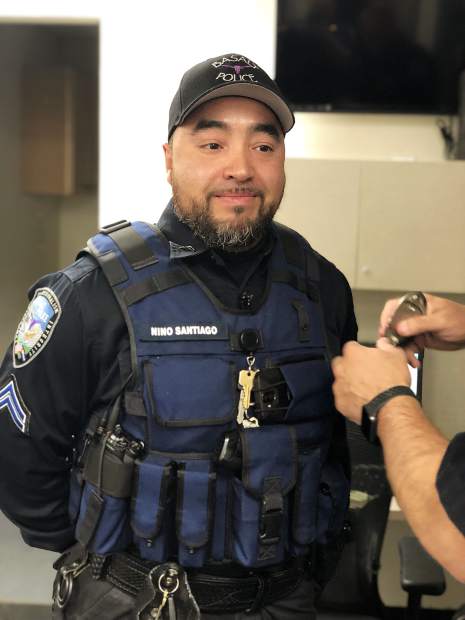

Provided
For many, the best way to remember and honor the men and women who died while serving in the U.S. military is to tell their stories and to keep their spirit of service alive.
For veterans, the military is a tribe where the fallen hold a special place, and each member shares a formidable bond. And while area veterans Nino Santiago Jr., Pat Hammon and Tim Hayes have traveled different roads throughout their careers, somehow they have all arrived at the same place.
A Puerto Rico native, Santiago was raised in north Philadelphia, which, at the time, was known as the murder capital of the U.S. He describes it as a poverty-stricken neighborhood full of crime, gangs and drugs.
“My mother had me when she was 16, and my father (Nino Santiago Sr.) joined the Marine Corps when he was 18,” Santiago said.
On June 11, some local restaurants throughout the area will participate in “Dining Out for Vets,” by donating a percentage of proceeds from meal checks to the fund.
His parents divorced when he was 2. During his elementary and middle school years, his mother wanted him to attend the best schools, but it was a challenge.
“This was during a very racist period in Philadelphia, and it was a fight to get to and from elementary and middle school every day,” he said.
Growing up, Santiago did not know his father, but at 18, just like his father, he joined the Marine Corps for its reputation as an elite tribe that promised discipline and training.
“I needed that,” he said. “I wanted to get out of Philadelphia, and I wanted to know something about my father, who was a Marine.”
In 2004, when Santiago got out of the Marines, his father was then a police officer for the Carbondale Police Department. By then, Philadelphia had become overrun by gangs, and his father knew Santiago had friends who were active gang members.
“Most of my friends had since joined different gangs, and they put me in a bad situation where they tried to force me to pick a gang,” he said.
His father didn’t want him to go down that path and knew that if his son became a police officer, it would give him the opportunity to serve again, train, lead and be part of a team.
“He asked me to move here, and I took his advice,” said Santiago.
Doing that gave him and his father time to rebuild their relationship.
“I became a police officer for the town of Carbondale, where my father was also an officer, and our relationship was everything I’d imagined it should have always been.”
But, on March 22, 2011, everything changed again. That night, when Santiago and his father were both on duty, his father took his own life.
“This is one of the many reasons why PTSD and officer suicide are very important to me,” said Santiago.
“There is nothing more important to me than legacy,” he said. “God has placed me in every place, location and situation I had to be in for a great foundation.”
Santiago said his mission is now to empower the youth and Latino community who come from backgrounds like his. Santiago was just recently promoted to corporal at the Basalt Police Department.
“Prior to that I was the community resource officer, and it truly allowed me the opportunity to become one with my community,” Santiago said. “In this role, I hope to be a part of helping all of our team members become the best versions of themselves.”
nursing instructor saw time in vietnam
Pat Hammon of Eagle remembers the first time she wanted to become a nurse.
“I was in sixth grade, and I did an aptitude test, and my teacher made fun of me in front of the whole class because I wanted to be a forest ranger, and that was a man’s job,” said Hammon. “My options were to be a teacher, a secretary or a nurse. I decided to become a nurse like my mother.”
Ten months after nursing school and additional training, Hammon received orders for Vietnam. A New Jersey native, she quickly found herself on a plane with 10 other nurses bound for Tan Son Nhut Air Base in South Vietnam to serve with the U.S. Army Nurse Corps.
According to the Department of Defense, Hammon would become one of the 6,250 nurses who served in Vietnam.
As Hammon stepped off the plane into the hot, stifling humidity of South Vietnam, 1960s rock ’n’ roll music blasted throughout a dusty airfield. Next thing she knew, they were sleeping in barracks with windows covered in chicken wire.
“In the middle of the night the ammo dump got hit, blew up and sent debris flying everywhere. We hid under three-tiered bunks, shaking,” said Hammon. “That was my welcome to Vietnam.”
She was 22 years old, and it was 1968.
A few hours later, she was at the 24th evacuation hospital in Long Binh, a 468-bed hospital that specialized in brain and spine injuries.
“I worked in the emergency triage area, and I learned very quickly to keep my mouth shut,” she said. “As a brand-new nurse, I knew very little.”
Hammon worked 12 to 14 hours a day, six days a week, or more, in difficult circumstances dealing with injuries that were unfathomable to a young nurse.
Hammon said she was in a platoon with soldiers who were great mentors.
“I was working with some amazing master sergeants who had been in the Korean War, and they knew everything,” she said. “I learned everything from them. You learn more than you can possibly learn from textbooks or anywhere.”
Decades later, Hammon would use the same style of leadership and mentorship throughout a 30-year career as a nurse that included teaching certified nursing aides at Colorado Mountain College.
Back in the U.S., Hammon’s first job out of Vietnam was at Veteran’s Affairs in Washington, D.C., in the Intensive Care Unit.
“We all had some PTSD,” said Hammon, “but I came back and went to work.”
She helped train some of the first paramedics in the country with the Bethesda Heart Association.
“The idea of paramedics came out of Vietnam,” said Hammon. “We had to stabilize soldiers before they were transported.”
By doing that, they had to learn to do it safely, correctly and quickly.
“Before paramedics, the ambulance driver would drive like hell and hope the patient wouldn’t die before arriving at the hospital.”
Hammon is most proud of helping build the Vietnam Women’s Memorial in Washington, D.C., dedicated to the women of the United States who served in the Vietnam War.
glenwood gathering place
There are 417,000 veterans in Colorado, and approximately 7,200 of them live in the communities from Aspen to Parachute and throughout the Eagle Valley.
Every Thursday, 20 to 30 of them gather at the Jesse Beckius/Casey Owens Veterans Resource Center in downtown Glenwood Springs, named for two local Marines who took their own lives after returning from Iran and Afghanistan.
Because of their tragic stories, local veterans have made it their mission to ensure that never happens to another veteran.
To that end, the center is a place where the tribe gathers to share their knowledge with the community.
“It’s the trust and the tribe,” said Hammon. “In the tribe, you understand because you are surrounded by military brothers and sisters. It’s a deep trust that civilians do not understand.”
Western Slope Veterans Coalition, also based at the center, believes that getting people together to tell their stories breaks barriers and helps decrease isolation among veterans.
“That’s the magic,” Hammon said. “People can talk about things they have never talked about; it’s therapeutic and it’s an invaluable tool.”
It can be a life-saving measure for veterans who may have chosen to isolate themselves and then, through WSVC, get connected with other veterans.
“All of a sudden they are out the next weekend fly fishing with five other veterans,” Hammon said.
deeper connection
Army and Vietnam veteran Tim Hayes knows about the tribe.
“In Vietnam, all we had was the tribe,” he said. In 1968 he served in a combat zone near the Vietnamese Demilitarized Zone and was wounded by a mortar blast when his company was establishing control of a North Vietnamese-controlled area. After returning from the war, he earned a bachelor’s degree in education, taught for many years, and also earned a degree in psychology. After teaching, he worked for 23 years as a counselor.
“I used my experience and worked with kids who had been traumatized or abused,” Hayes said. “I understood the pain and the loss they experienced.”
Hayes says that he could sense what he needed to say, and he knew when to talk and ask questions because he had done the healing work in his own life stemming from his own traumatic experiences in Vietnam.
In some ways, Hayes said, he had a deeper connection with those he served than with anyone else.
“Love is not sexual. It’s a close connection with a soul with another person and people you trust,” he said. “Love comes out of that being fulfilled.”
Connection to resources is a critical service WSVC provides. One of the greatest needs of veterans and their families is to get assistance with their military discharge papers called DD Form 214. It’s the form veterans need to claim their benefits. They also need it for jobs, schooling, mortgage loans and military funerals.
“Without it, you don’t go to square one,” said Hammon. “It’s their window into the VA.”
The WSVC board of directors comprises Hammon, Hayes, two other veterans, and three community members who, as part of their duties, manage the center’s emergency fund, which provides immediate assistance to veterans and their families.
On June 11, some local restaurants throughout the area will participate in “Dining Out for Vets,” by donating a percentage of proceeds from meal checks to the fund.
For veterans like Santiago, Hammon and Hayes, their service never stops. For them, Memorial Day isn’t just about one day, it’s about every moment. After living through intense experiences, all three, in their own way, found a way to continue to serve.
“I learned so many things from my father,” said Santiago. “But most applicable for me was the habit of engaging in consistent action. He taught me how to not only use motivation to complete goals, but to build a habit to make them just what I do and to live with honor, integrity, commitment and professionalism.”
That’s how the tribe honors their own every day.
